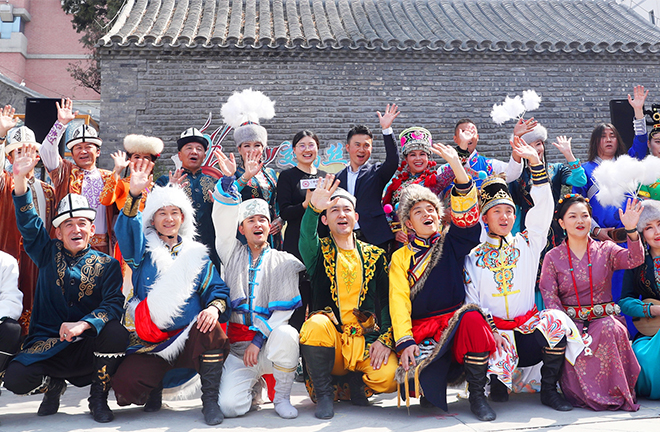Symposium decodes formation of community for Chinese nation

Performers dressed in the traditional attire of various ethnic groups pose for photos at the former site of the Mongolian and Tibetan School in Beijing. Photo: IC PHOTO
On Dec. 28, 2024, a symposium was held at Hubei University to explore the Yangtze River civilization and the construction of the community for the Chinese nation.
The origins, formation, and development of Chinese civilization was complete and continuous, said Han Jianye, a professor of history from Renmin University of China. The Chinese nation’s cosmological, ethical, and historical perspectives have been preserved from prehistoric times to the present, as have its material and institutional inventions. Additionally, the core ethnic, linguistic, and scriptural elements of the nation have maintained an unbroken lineage.
Che Huaiming, former Party secretary of the Tibetan Academy of Social Sciences, noted that the Yangtze River not only illustrates the natural phenomenon of “all rivers flowing into the sea,” but also integrates the cultural contributions of the ethnic groups along its course into the mainstream of Chinese civilization.
Archaeological evidence demonstrates that ancient populations in the upper reaches of the Yangtze River utilized its water networks, traveling upstream or downstream to seek natural and cultural resources conducive to survival and development. These efforts fostered dynamic exchanges among ethnic groups, Che explained. Over time, these groups in the upper Yangtze region overcame geographic divisions, forming an interconnected and interwoven multi-ethnic community.
The community for the Chinese nation has evolved like a “snowball,” with diverse ethnic groups integrating through exchanges and deepening those exchanges amid integration, ultimately shaping the inclusive Chinese nation. Ma Guoqing, former vice president of Minzu University of China, emphasized that the “unity in diversity” pattern of the Chinese nation stems from nearly 10,000 years of interactions, convergence, and mutual influence among regional cultures, as well as the countless combinations, reorganizations, and reunions of ancestral ethnic groups.
Through prolonged interactions, exchanges, and integration, China could boast unique cultural heritage as a highly cohesive community, Ma said. Within the community, ethnic groups have been interactive, organically linked, and symbiotic, which is critical to understanding the community for the Chinese nation.
Shi Shuo, a senior professor of the humanities and social sciences at Hubei University, pointed out that the Chinese nation was historically formed as an organic whole through mutual integration, interdependence, and interconnectedness among ethnic groups. This process was closely linked to China’s inward-facing geographical environment. He further elaborated that this relatively enclosed and independent geographical environment provided ample opportunities for ethnic groups to mingle and blend, gradually fostering cultural commonalities. Over time, shared historical memories and collective fates gave rise to a strong sense of community.
Duan Chao, former vice president of South-Central Minzu University, highlighted the vital role of ideas concerning ethnic integration in the formation of the community for the Chinese nation. He traced the evolution of the concept yi xia or hua yi (the relationship between Han and non-Han ethnic groups) from “distinction between yi and xia” to “both yi and xia are orthodox,” then to “hua and yi are one family,” and finally to “hua and yi are integrated.” Examining these shifts in the yi xia thought offers valuable insights into the formation and historical development of the Chinese nation, summarizing its developmental experiences, and entrenching the sense of community, thereby realizing national rejuvenation, Duan asserted.
In Duan’s opinion, this transition from distinction to integration between Han and non-Han ethnic groups laid a crucial intellectual foundation for the formation of the Chinese nation, as well as the community, even the unified, multiethnic nation. This process reflected the continuous interplay and fusion of ethnic cultures throughout the nation’s history, fostering a sense of belonging in terms of intellectual and cultural identity.
Li Dalong, a professor from Yunnan Normal University and research fellow from the Institute of Chinese Borderland Studies at the Chinese Academy of Social Sciences, believes that the emergence of the term “Chinese nation” marks the realization of the community’s self-consciousness. Understanding the process by which this community was consolidated is essential for strengthening its consciousness and achieving the great rejuvenation of the nation.
Li proposed defining the meaning and attributes of the “community for the Chinese nation” from the perspective of the “state.” He suggested interpreting its formation and development through the transition from a “state under Heaven” to a “sovereign state,” analyzing its essence through the lens of ethnic integration, and establishing a holistic historical perspective on China as a multiethnic nation and the community for the Chinese nation using the concept of “all under Heaven.”
Edited by CHEN MIRONG

 PRINT
PRINT CLOSE
CLOSE